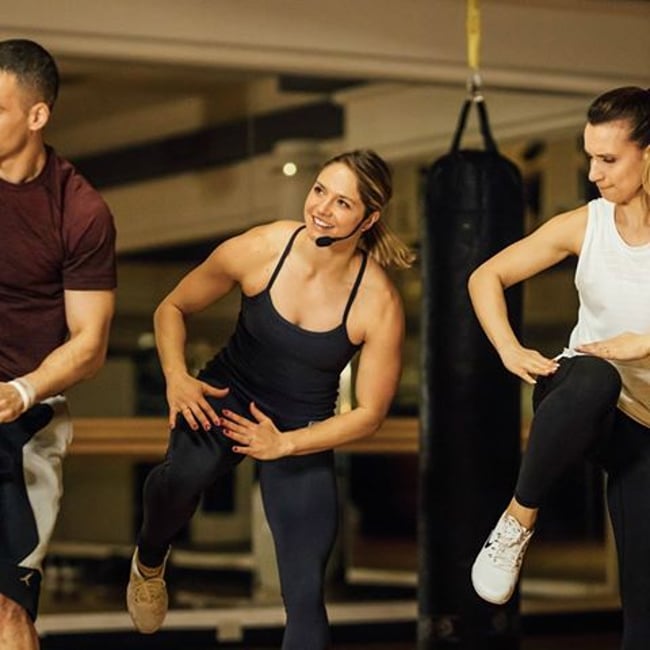Fitness Schedule vs. Strategy Part Two: Get the Timing Right
Learn how to fine-tune your newly complicated schedule.

“Lack of time” is one of the most common excuses people give when asked about barriers to regular exercise. Maybe one reason this is true for so many is because in-person classes tend to be an hour long and virtual home workouts “don’t count” for some people. Let’s challenge this belief in part two of the Strategy vs. Schedule series by evaluating the duration and timing of our classes—both in person and virtual. There are many strategies you can use to create a logical fitness schedule that fits consistently into your participants’ lives.
See also: Fitness Hybridization: Strategy vs. Schedule, Part One
Tactical Timing
Let’s start with “traditional” scheduling, which takes into account typical time blocks familiar to us all: morning, midmorning, midday and evening. In the past, perhaps you’d look at the week ahead and offer two or three of the same class type during these time blocks. In the “new world,” it’s best to “zoom in” and offer one or two slots of a particular offering. You can reevaluate after 1–2 months and, if necessary, add more.
COVID-19 has changed our participants’ behavior and is still wreaking havoc on school and work schedules. Then there’s the weekend, an entirely different scheduling beast. Whether you’re starting from scratch or adjusting your current fitness schedule, finding the right time for your in-person and digital classes will take trial and error. Below are three essential rules to follow when determining days and times for your classes in this new paradigm. Prioritize building the schedule before selecting instructors, don’t base decisions on what has worked in the past, and always have one ear to the ground.
- Build a fitness schedule that works as an ecosystem. Don’t schedule a class based on a particular instructor’s schedule, no matter how good the instructor may be. If instructors’ schedules rule your offerings, you will run into issues. Instead, look at your client base as an integrated ecosystem and let that drive your decisions. In short, let your participants inform your process.
- Avoid basing your new fitness schedule on the past. It’s tempting to think that you’ll be able to give veteran instructors the same opportunities as you did pre-pandemic. Reconsider that mindset and communicate the new expectations and needs to your team. As referenced in the first article of this series, you will want to provide an umbrella of offerings that occur at various times of the day on multiple days of the week. A general rule of thumb is to consider the formats you offer as the foundation.Let’s say you provide multiple format options, such as strength, cardio, dance and mind-body. You may now want to offer a more targeted list within those formats. Focus on strength for specific body parts in your strength classes or get specific with the types of yoga unique to your participants’ needs. Offer each one at least once per week in various time blocks, and then add details such as the instructor, location and equipment. This adds variety to the foundation. Stay curious and informed about what’s happening both within the facility and throughout the community. Ask questions of both members and your team. Instructors get real-time feedback, but they may not always feel confident in sharing unless they’re encouraged to do so. Consider that work schedules have shifted and that seasonal changes in attendance, due to weather and holidays, are still relevant.
- Enhance with digital offerings. Your current and future participants’ behavior has changed—perhaps permanently. Rebuilding your fitness schedule is a path to discovering what works now, while simultaneously predicting the future. Online offerings can help with this. By offering virtual options, you can gather valuable data and insights, such as best hours, check-in trends and how schedules affect attendance. You can also educate participants and build suspense. As you assess, experiment with and unveil more offerings, virtual can become a tool to excite members who are returning to in-person classes, while keeping you in touch with those who are sticking with online options.
See also: Adding a Class to Your Schedule
Solving the Duration Dilemma in a Fitness Schedule
The 1-hour workout is a thing of the past. People have fallen in love with 15- to 45-minute classes because they make it easier to customize a fitness schedule to fit their specific needs. Also, those new to exercise can test different class lengths, and shorter classes are less intimidating.
Consider offering short in-person formats to complement your longer ones and give participants the power to construct the workout experience. They can attend multiple short classes in a row or jump into one that dovetails nicely with another workout. For example, a participant might take a 30-minute HIIT class, followed by a 20-minute core-focused class, and then finish with 30 minutes of stretching.
For the virtual environment, ensure that your offerings have the same (if not more) variety in duration. Get creative with 3- to 5-minutes tutorials that educate and motivate participants about your fitness schedule and show how to make it work best for them. Give people the opportunity to meet your team, and stress to instructors the importance of keeping classes short, efficient and effective. The virtual environment is different from being in person, and participants likely won’t have the attention spans for a drawn-out intro, warmup or cooldown.
Consistent Curiosity
Many variables will affect how well your classes are attended. Build your in-person and digital fitness schedules months in advance and program enrollment classes to end or pause before school breaks and big holidays. Stay aware of traffic trends and do your best to forecast needs by remaining connected with the community. Lean on your instructors. It’s likely that many of them are parents, work with participants and/or have kids who go to the same school.
Also, pay attention to other areas of your business. What amenities are people using? What interests do they have outside of fitness that may affect their ability to attend? How are check-ins trending? For example, maybe there’s an increase in visits over the weekend compared with years past. This may mean your participants are more willing to commute to the facility when they have more time to enjoy the other amenities.
Virtual classes can be a valuable resource for adjusting or discovering new formats that might work well in person. If you work with a digital platform, it likely provides user analytics, such as number of videos viewed per person, length of views, time of day or day of the week watched, etc. This will help you investigate what’s working and what’s not. As you reach out to members about their experiences, both in person and digital, ask which options they’ve tried, and why or why not.
Scheduling is a constant challenge. There will be times when in-person classes are strong and other times when virtual classes will surge. The question is: Can your schedule satisfy your current participants’ needs as well as reach a new audience? The most successful programs will be determined by attentive leaders, reliable instructors, and ongoing reassessment and adjustment.
See also: Organizational Efficiency: Perfecting Your Priorities
Staci Alden
Staci Alden is committed to helping group fitness managers elevate their programs, instructors, and leadership skills through her writing, presentations, and YouTube channel. For more than a decade, she has overseen a team of over 100 private Pilates and group fitness instructors at a luxury health club in Seattle, Washington. Staci also is certified as a master Balanced Body® barre and MOTR® instructor.





